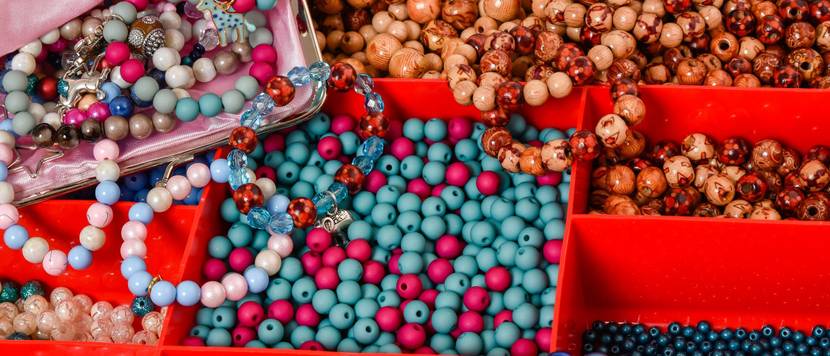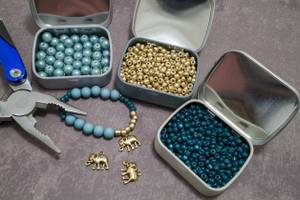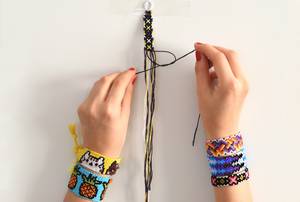
Jewelry is no longer a gift just for women. Bracelets, necklaces, etc. can be worn by anyone and quickly transform simple clothing into an extravagant outfit. Making jewelry yourself is a great activity for all creative people, hobbyists and DIY lovers.
In the Heimwerker.de editorial team we have put together which materials you can use to make bracelets yourself, on which occasions you can give them as gifts and Finally, we will introduce you to a braiding technique for your own macrame bracelet.
1. Material etc.: What is best for arm jewelry?
In principle, there are no limits when it comes to materials. Anything that fits around the wrist can be worn as arm jewelry. However, when it comes to jewelry that is intended to be worn in everyday life or for a longer period of time, there are a few criteria that the material should meet:
-

Pearls come in different types, shapes and sizes.
Durability of the material: A bracelet can be worn for long periods of time very wear and tear. This makes it all the more important to have a material that doesn’t break, discolor or look worn out after just a few weeks.
- Coziness: If jewelry isn’t comfortable to wear, people often don’t want to put it on. A scratchy bracelet, too many pendants jingling when typing on the computer or the bracelet getting stuck everywhere – if one of these is the case, most people no longer want to wear the piece of jewelry in everyday life.
- practicability: Every person has a different everyday life, different hobbies and Therefore, you also need individually tailored jewelry. The shape, pendant and material should also depend on the everyday life of the person receiving the gift.
If you are clear about what you need to pay attention to when it comes to material for the people you are giving gifts to, there are still ideas and alternatives you can use. Below we have put together a table in which we briefly explain materials and their properties:
| material | Characteristics |
|---|---|
| line |
|
| Wool |
|
| Metal chains |
|
| Leatherette |
|
1.1. What accessories do I need besides my line?

Glass beads in particular have a beautiful shine on the bracelet.
Once the material is selected, it’s about the decorations, pendants and clasps that are needed. Many craft supply stores sell sets of charms and beads that you can thread onto your string.
Depending on the reason for the gift and the person themselves, various options come into question. We have noted the most common ones for you here:
- Glass beads, wooden beads, plastic beads
- Natural stone
- Ceramics
- Silver pendant
But a string of beads alone doesn’t make a bracelet. because closures and other intermediate elements are still missing. There are special caps for pearls that can be used for decoration, as well as metal clasps that simply need to be tied into the bracelet. Alternatively, you can also learn braiding and knotting techniqueswhich then create a closure.
Straight cord or nylon wires are very soft and knots can come undone quickly. That’s why we give you the tip to put a shot of craft glue on the knot, which holds the cord in position and seals it.
2nd birthday, wedding, anniversary: for which occasions can you make your own crafts?

You shouldn’t just give out gifts on special occasions.
You don’t always need an occasion to give a bracelet as a gift. You can also give bracelets to good friends or family every now and thenthat you made yourself. However, there are some occasions where a homemade bracelet is very suitable as an addition to the actual gift or as a small gift.
- Birthday: The most obvious reason for gifts is a birthday. No matter whether it’s for mom, dad or friends, a bracelet is a nice gift for everyone. You can also do so on the Internet Design braceletsfor example with a date or motif on a metal plaque.
- Wedding: Homemade bracelets are a great gift option for both guests as a welcome gift and for the bride and groom themselves.
- Valentine’s Day: Although Valentine’s Day brings with it mixed feelings for many people, you can use the day to put a smile on someone’s face, whether it’s a romantic interest or a purely platonic one.
3. Instructions: Make your own macrame bracelets with beads
Do you have a desired material and the occasion in mind? Then you still need the first inspiration to make a beautiful bracelet yourself. Below we offer you simple instructions for a braided macrame bracelet decorated with beads.
Material list:
- Waxed cotton cord (1 mm thick)
- Beads in desired color (about 3 mm thick)
- Jewelry glue
- Scissors
- Washi tape for attaching to a surface
Once all the materials are together, you can get started. In 8 steps we want to show you how you can easily braid the bracelet.
-

Macrame are many braiding and knotting techniques for beautiful jewelry.
The cotton cord must come first be cut into the correct lengths. The first cord should be as long as the bracelet needs to be long; it serves as a guide line. To do this, place the cord around your wrist and measure how much cord is needed so that the band fits but does not become untied. Also take the type of closure into account in the length. The second cord should be about 2.5 times as longlike the guiding line.
- Put the guide line into a tight loop and attach it to a surface with some washi tape. Next, cut the working cord to a point and rub the tip with some jewelry glue. This will help you get the string through the beads better later.
- Now the working line has to be done secured with an overhang knot around the guide line. For further understanding, the tip with the jewelry glue should be on your right side. The knot is then tightened tightly.
- Well the first cross knot follows. Thread a bead onto the right cord, then pass the cord under the central guide cord, the left cord is passed over the central guide cord and then you have to tighten the knot.
- Now turn the whole thing over. You thread a bead onto the left cord, pass it under the guide cords and then take the right cord, pass it over the top and then tighten the knot.
- Repeat steps 4 and 5 until you reach the bottom. However, consider the length you need for the closure.
- The work cords must be shortened and are then sealed with jewelry glue and attached to the guide line.
- Peel off the washi tape, Your loop and the end of the guide line now form the simple one Closure type.
Image credits: StockAdobe/unikat, StockAdobe/unikat, StockAdobe/cobaltstock, StockAdobe/Unregardphotography, StockAdobe/Tatiana (sorted chronologically or according to the order of the images used in the buying guide)